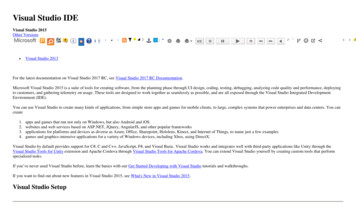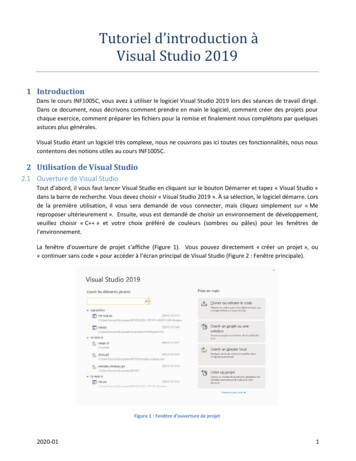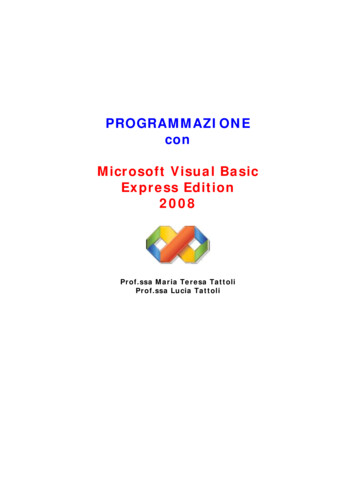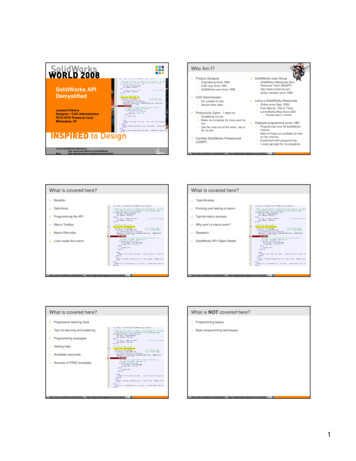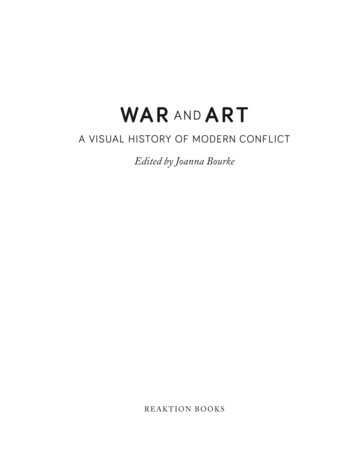
Transcription
WA R A N D A RTA VISUAL HISTORY OF MODERN CONFLICTEdited by Joanna BourkeREAKTION BOOKS
CONTENTS7INTRODUCTION JOANNA BOURKEHISTORIES44 WarImagery between the Crimean Campaign and 1914Sergiusz Michalski80 TheTwo World WarsMonica Bohm-Duchen128 Inthe Heat of the Cold War, 1945–77Sarah Wilson166 ContemporaryWar; Contemporary ArtSue MalvernGENRES196 ropaganda, Art and WarPJo Fox203 Warand FilmJames Chapman209 TrenchArt: Objects and People in ConflictNicholas J. Saunders216 Visionsof the Apocalypse: Documenting the Hidden Artworkof Abandoned Cold War BasesJohn SchofieldARTISTS226 Kiyochika’sLast Laughs: Satirical War Prints from the FirstSino-Japanese (1894–5) and Russo-Japanese (1904–5) WarsJohn D. Szostak237 ‘Infront of me is the war, and I battle with it with all my strength’:The Wars of Vasili Vereshchagin and Natalia GoncharovaAnna Pilkington244 ‘Themost gruesome picture ever painted’:Otto Dix and the Truth of WarGary Haines
252 KätheKollwitz and the Art of WarJay Winter268‘ A concentrated utterance of total war’:Paul Nash, C.R.W. Nevinson and the Great WarPaul Gough281 I Do (Not) Challenge: Nancy Spero’s War SeriesJon Bird291 ‘Myname is David and I will be your war artist for the day’:David Cotterrell Shoots a VideoMichael CorrisCONTEXTS302 Drawnin Blood and Bone: The Art of Captives of WarClare Makepeace310 TheCrayon War: How Children Drew the Great WarManon Pignot316 Rapein the Art of WarJoanna Bourke324 VideoGames, War and Operational AestheticsPatrick Crogan330 ArtAgainst WarGrace Brockington339 R eferences367 Bibliography370 Noteson Contributors374 Acknowledgements375 Photo382 IndexAcknowledgements
INTRODUCTIONJOANNA BOURKEOne cannot look at this . . . This is too much! . . . Why?Francisco Goya, ‘The Disasters of War’ (1863)War is the most destructive activity known to humanity. Its purposeis to use violence – plunder, forced migration, wounding, starvationand slaughter – to compel opponents to submit and surrender. Lookingclosely at military violence can itself be painful: along with Goya, wemay simply exclaim, ‘This is too much!’Throughout history, though, the practice and representation ofwar have been intertwined: the ‘art of war’ refers both to the strategicaspects of military operations and to its depiction in artistic imaginaries.This is exemplified in Sun Tzu’s The Art of War, a treatise dating fromthe fifth century bc. In it, military strategists are reminded that just as‘in battle, there are no more than two methods of attack – the direct andindirect – yet these two in combination give rise to an endless series ofmanoeuvres’, so, too, ‘there are not more than five primary colours . . .yet in combination they produce more hues than can ever be seen.’ Thisglobal history of war art explores some of the ways artists have blendedcolours, textures and patterns to depict wartime ideologies, practices,values and symbols. It investigates not only artistic responses to war,but the meaning of violence itself.Representations and reflections on war are legion. Artists have turnedto oil and water paints, pencils and crayons, silk and wool, carved wood,INTRODUCTION 7
photographic film, digital technologies and blood. The mark of war hasbeen imprinted on everything from stretched canvases to the fuselagesof fighter planes. Cheap and easily reproduced woodcuts and stencilshave proven essential to artists everywhere, but particularly to thosewith a political message to communicate to the masses. Front-line participants in war have carved art from the flotsam of battle – bullets, shellcasings and bones – often producing unsettling accounts of the calamitythat had overwhelmed them. Tools of cruelty have been turned into testaments of compassion, as in the Mozambique project taf (TransferringArms into Ploughshares) in which recycled weapons are crafted into useful farming tools.1 Civilians have been equally resourceful. Creating ‘artout of rubble’ has engaged the imaginations of millions of people trapped1 Absolut Vodka redesigned by trio Sarajevo, 1994.8 WAR AND ART
in war zones. This includes Sarajevan artists Bojan Hadžihalilovićand Dada Dalida Duraković, who used pop designs and icons suchas Absolut Vodka, a Campbell’s chicken soup can and Superman tocomment on the war in Bosnia (illus. 1).2 As Izeta Gradevic (directorof the Obala Art Centre, an alternative art space in Sarajevo) explained,art is more effective than news reportage in drawing international attention to the plight of ordinary people at war. ‘When you face an art form,’Gradevic explained, ‘it is not easy to escape death.’3It is impossible to do justice in one volume to such variety.Attempting to write a global history of any phenomenon is necessarilyreductive. Human culture is infinitely complex. When the timeframeextends over the two centuries between the Crimean War and thepresent, there is also a risk of emphasizing similarities over differences.Although there are many shared ‘graphical communities’,4 this mustnot be exaggerated.The declaration of war typically triggers practical difficulties forartists. At the very least, the sense of crisis risks relegating the arts toa minor role in society. As Charles C. Ingram, acting president of NewYork’s National Academy of Design, complained in 1861, the ‘greatRebellion’ had ‘startled society from its propriety, and war and politicsnow occupy every mind’. He lamented that ‘No one thinks of the Arts’and even artists had set aside ‘the palette and pencil, to shoulder themusket’. He begged artists not to ‘in love of country, forget the loveof art’.5 Those who continue to practise their art often find that thechanging circumstances radically constrain their creative enterprises.The state appropriation of space sees exhibition possibilities plummeting.Economic sanctions severely limit the availability of supplies. Japaneseartists during the Second Sino-Japanese War, for example, facedrestrictions not only of paint, but of materials such as silk, gold andmineral pigments (including semi-precious stones) that had been usedto create Nihonga or traditional Japanese-style paintings.6 Galleries,museums and art studios are reduced to rubble.Everything from excitable patriotism to down-to-earth curiosityhas led millions of artists into the heart of darkness. Some artists wereofficial appointees, sent by their governments to create a record of ‘whatwas happening’ or to offer visual slogans to aid morale. Voluntarilyengaging in active war service could allow artists to circumvent someof the restrictions created in wartime. In fact, governments often provedwilling to support artists who threw themselves into the war effort.As the New York literary journal The Knickerbocker extolled at the startof the American Civil War, ‘artists! . . . remember that your elegantbrushes are recording the history of a nation.’7This required artists to serve the interests of the collective,however. Many struggled to resolve the tension between artisticfreedom and censorship. Was their art supposed to bolster recruitmentor demonize the enemy? Were they expected to provide a visualreminder for people back home of the travails of modern combat orto honour those who suffered? Were the two incompatible? ShouldINTRODUCTION 9
their representations of violence aim to reduce the possibility of futurecarnage? Were they expected to be ‘official war artists’ (as British artistswere called during the First World War) or ‘official recorders’ (as theywere renamed during the first Gulf War)? Even the most messageorientated artist might find that they had little control over the way theirimages were used. They returned from the front lines to discover thattheir sketches had been altered or even brazenly distorted by publishersand propagandists.Was it the job of artists to reconcile people to war? German artistOtto Dix thought not. His painting Trench is a searing indictment of theinhumanity of war, but critics were appalled. In the Kölnische Zeitung,Cologne’s most popular daily paper, Walter Schmits complained thatTrench weakened ‘the necessary inner war-readiness of the people’ andoffered people ‘no moral or artistic gain’. Museums are ‘for art . . . notpropaganda’, he insisted.8 An unnamed author writing in the Bulletinof the Art Institute of Chicago in 1918 agreed that war art should bepositive. He argued that it was ‘the peculiar function of the imaginativearts’ during times of military conflict to ‘hint at uncanny meanings, to2 Saburo Miyamoto, The Meeting of General Yamashita and General Percival, 1942, oil on canvas.10 WAR AND ART
3 Tsuguharu Fujita, Desperate Struggle of a Unit in New Guinea, 1943, oil on canvas.reconcile the human spirit to the things which the human fleshmust undergo’. It was even more imperative, he continued, for artiststo boost morale. To make this point, he told a story about a pet apewhose master dressed him in a silk hat and a high collar. One hotsummer the master took pity on his pet and so removed the stiflingcollar. Immediately the ape ‘fell . . . upon all fours and became a wildbeast again. He had simply lost his “morale”.’ The lesson was clear: asimilar reversion to the primitive might occur if ‘we allow ourselves to bedivested of the arts which civilization has evolved’. Art, sculpture, musicand literature were essential for the healthy ‘morale of the community,the family, and the individual’.9Many artists embraced this role. In Japan, for example, sensõga(or Japanese war painting) maintained its well-established propagandafunction. Saburo Miyamoto’s Meeting of Commanders Yamashita andPercival (illus. 2) is a powerful example. The painting shows negotiationsbetween Japanese and British generals during the surrender inSingapore, one of the most humiliating defeats in the history of theBritish army. In contrast to the forceful presence of General TomoyukiYamashita (‘The Tiger of Malaya’), the commander of the forces ofthe British Commonwealth (Lieutenant General Arthur Percival) isportrayed as cowardly and arrogant. The painting won the ImperialArt Academy Prize for 1943 but, more importantly, it was hoped thatit would bolster morale at a difficult point in the war.The sensōga tradition was awkward for artists who sought todepict the horrors of war. Artists became embroiled in controversy whenthey exhibited more brutal representations of war. In 1943, for example,Tsuguharu Fujita exhibited Desperate Struggle of a Unit in New Guinea(illus. 3). It depicts a fierce battle scene based on the defeat of CaptainINTRODUCTION 11
Yasuda’s troops in 1942. Drawn in muddy browns, there are no cleardistinctions between combatants on either side. War hurts. Everyone.Although military commentators praised the realism of the work,even using it to encourage kamikaze pilots,10 others were disparaging.Ishii Hakutei, one of the founders of the sōsaku hanga (creative print)movement, doubted that the painting would be ‘useful . . . in drummingup war spirit’. There was ‘a danger that the viewer will sense evil beforeadmiring the loyalty and bravery of the imperial troops’. Previously, hecontinued, artists ‘exercised consideration by not showing dead bodies’,despite the fact that ‘a war without dead bodies is unthinkable.’ Artistslike Fujita had gone to an extreme, ‘evoking oppressive associationsfor bereaved families and others’.11Conscious of the power of representation, governments routinelyseek to control the framing of visual messages. During the SecondWorld War, for example, American photojournalism was limited toimages produced by members of the Still Photographic Pool, consistingof three major picture agencies (Associated Press, International NewsService and Acme Newspictures) and Life magazine. As a journalist inPopular Photography explained in 1943, all photographs had to be ‘clearedofficially through Washington before being released to the press’. The‘pool has been a complete success’, the journal hastened to reassurereaders worried about being manipulated.12Another way the military attempt to control their image isthrough embedding artists within military units. During the wars ofindependence, for example, Vietnamese and Cambodian artists wereexpected to be fully functional ‘cultural soldiers of the revolution’.13Not only did artists travel with the army, but an art school was evenstationed within the Viêt Minh revolutionary planning hideout inthe hills of Viêt Bác.14In contrast, the free-ranging American artists of the VietnamWar era (immortalized by the photojournalist played by Dennis Hopperin Apocalypse Now) and the subsequent public outrage expressed whenthey showed images of carnage made the military services profoundlywary of civilians near the battlefields. However, official attempts toseverely limit the movement of artists and journalists during the firstGulf War also met with indignation. More successful was the Pentagonpolicy of officially attaching journalists, including photographers andother artists, to military units, where they shared tough training regimesand front-line hardships. During the invasion of Iraq in 2003, nearly600 were embedded with the u.s. and coalition forces.15 Cynics expressedconcern that artists were actually being implanted in the propagandamachine, entrusted with the job of selling the war to the Americanpublic and their allies. More hostile voices made snide comments about‘Stockholm syndrome’. In any case, official attempts to either censoror seduce war artists have more recently been undermined by digitaltechnologies and the proliferation of independent producersand distributors, as well as online sharing facilities.12 WAR AND ART
Not all artists who turned their creative energies towards questionsof military conflict had links to the armed forces or other governmentalbodies. Many identified themselves as independent painters,photographers, printmakers, sculptors, advertisers, graffiti artists orcartoonists who only incidentally addressed the topic of war. Somewere journalists, ngos, international activists and even guerrillas. Alarge proportion may not have seen themselves as ‘artists’ at all: theymade sketches or trench art for their own private purposes and onlylater did these representations enter the public sphere as ‘art’.Inevitably, such heterogeneity means that the very term ‘war art’is intrinsically contested. Not all ‘war art’ focuses on combat. Thousandsof official war artists produced paintings and sketches that never hintedat battle, let alone wounds. Indeed, one tradition of war art treats it asa kind of tourist billboard: ‘exotic’ locations are conjured up, strangecustoms fondly exposed. Nothing could be further from the traditionof war art that insists on the desperate hopefulness of prisoners-ofwar or the visceral horrors of trench warfare, the Holocaust or atomicbombardment.The term ‘war art’ also problematizes the concept of ‘war’. Shouldart produced in connection to ‘peacekeeping missions’ (in Cyprus orNorthern Ireland, for example) be considered ‘war art’? In periods of‘total war’, where the entire population is engaged in war-work, what isnot ‘war art’? At the other extreme, many populations are ‘at war’, yet theydon’t recognize it. This is the case in late twentieth- and early twentyfirst-century Britain and America, whose armed forces conduct militaryactions in many parts of the world, yet very few artists living in Londonor Washington would acknowledge that they live in war capitals.While the category of ‘war art’ is unclear, it is often assumedthat artistic representations of combat represent its exemplary form andthat it reached its peak in the nineteenth century. The ‘authenticity’ ofcombatant-artists is revered: the ability to say ‘I was there’ and so ‘thisis what it looked like’ is powerful. Art critic and dealer Robert Ross wasadhering to this ‘authenticity myth’ in a letter addressed to the novelistArnold Bennett in 1918. He observed that C.R.W. Nevinson’s Harvestof Battle might seem fanciful ‘to older people’, but soldiers ‘who knownothing of art (and are therefore the best judges)’ claim that it represents‘the spirit of the war better than anyone else’s’.16 The actor Leon M.Lion agreed. In a talk given at the Watford Labour Church entitled‘The Importance of Art in War-time’ (1920), he argued that Nevinson’sart was ‘implacable in its insistence on the truth, – War as it really is, –and awakening in us precisely that responsive emotion that the artistaimed at’.17 It was a point that war artists themselves recognized. Forexample, Dix once used pen and ink to draw a self-portrait of when hewas a machine-gun team commander. This is How I Looked as a Soldier(1924) shows a grim-faced soldier holding a machine gun: his uniformis torn; there is a bullet-hole in his helmet. The drawing insists on Dix’smembership of the warrior caste, as well as being an assertion of defiancein the face of palpable violence.INTRODUCTION 13
This veneration of the artist as ‘witness’ to front-line experienceshas two important consequences. The first is a refusal by some galleriesand collectors to purchase ‘war art’ when the artist has portrayedscenes that he could not have actually seen. This was the fate of PeterHowson’s extraordinary 1994 painting Croatian and Muslim, whichdepicts a vicious rape during the conflict in the former Yugoslavia.Although Howson was a government-sponsored war artist, the ImperialWar Museum decided not to include his painting in their permanentcollection on the grounds that Howson could not have witnessed therape that he painted on his canvas. It was not sufficiently ‘authentic’.As Paul Gough explains, the paintingpolarized two schools of thought: those that felt it necessary to depictthe true face of warfare using whatever means available to an artist,and those who argued that an artist must bear witness, ocular not justcircumstantial, to a scene of horror before committing it to canvas.18In other words, ‘bearing witness’ requires a certain kind of fidelity tothe ‘scene of war’ as seen. Manipulating war environments for artisticpurposes was disparaged, if not scandalous. Famous exposés of artistic‘stage management’ involved two photographers from the AmericanCivil War, Alexander Gardner and Timothy H. O’Sullivan, who arebelieved to have moved bodies and objects before taking their nowfamous photographs.19 The debate about whether Robert Capa fakedThe Falling Soldier: Loyalist Militia at the Moment of Death, CerroMuriano, September 5, 1936 still incites passion on both sides (illus. 4).Of course, one of the consequences of this emphasis on ocularauthenticity is that innumerable acts of war – most notably, as Howsondiscovered, wartime rape – would rarely, if ever, enter the war canon.By definition, raped women (and men) are rendered invisible.4 Robert Capa, The Falling Soldier: Loyalist Militia at the Moment of Death,Cerro Muriano, September 5, 1936.14WAR AND ART
5 Lady Butler (Elizabeth Thompson), Calling the Roll after an Engagement, 1874, oil on canvas.This implicit hierarchy of war art – the closer the artist is to‘the action’, the more ‘authentic’ – has another significant implication:it largely excludes female artists. It is not only that male artists have beenmore attracted to military tropes and are significantly more likely to beappointed as official war artists; they are also much more likely to havethe type of front-line combat experience that represents the pinnacle ofthe genre. Gender ideology has frequently constrained female painters to‘softer’ topics, specifically those associated with women and children onthe home front. A feminist politics of representation takes this argumenteven further, pointing out that war itself is phallic: women artists havea duty to repudiate its destructive fury.This is not to say that female artists have been absent altogether.Margaret Bourke-White (known as ‘Maggie-the-Indestructible’)20 wasthe first American female artist to be allowed to work in combat zonesand she and Lee Miller (noted for her images of the Blitz, field hospitalsin Normandy, the atrocities of Dachau and Buchenwald, and Hitler’sapartment) were distinguished photographers during the SecondWorld War.Arguably, though, the most influential female war artist of themodern period was the painter Elizabeth Thompson, later Lady Butler.She became an overnight sensation when, in 1874 and at the age of 28,her oil painting Calling the Roll after an Engagement was exhibited atthe Royal Academy and acquired by Queen Victoria (illus. 5). It showeda company of wounded and exhausted Grenadier Guards after anengagement during the war in the Crimea between 1854 and 1856. Thepainting changed the genre of war painting by focusing on the ordinarymen who suffered in war. She even positioned a dead soldier lying inthe snow near the middle of her canvas. Butler’s painting differed fromINTRODUCTION 15
previous academic paintings in its social realism and anti-heroism.Although her compositions were extremely popular, like many otherfemale artists Butler struggled to maintain her artistic renown afterher marriage. Her male successors were able to sketch the ‘real’ action,near the front lines, while she was forced to make compositions onlyby interviewing survivors. Her husband’s peripatetic life as an armyofficer and her responsibility for caring for their household (includingsix children) limited the time she had available for creative pursuits. Itis interesting to note that while she constantly referred to her husband’sachievements in her memoir, he never referred to her in all 455 pagesof his autobiography.21The dominance of male artists in war art has skewed therepresentation of women in times of war. Women are frequently absent.When they are represented they are typically nurses or nurturers. Somemale artists used their portrayals to denounce women’s roles. In theart of the Weimar period, for example, women are often representedas ‘whores’ who spread syphilis. Prominent examples are the corpulentprostitutes who tower over disfigured soldiers in Dix’s etchings entitledVisit to Madame Germaine’s in Méricourt and Front-line Soldier in Brussels(both 1924). Such paintings even imply that women might be responsiblefor the carnage of the war. Might war be proof that women’s ‘natural’pacifism had failed? Women had not only sent their brothers, husbandsand sons to be mutilated or killed, but had profiteered from the conflict.From the 1960s the gendered nature of war art underwentdramatic shifts, largely as a result of two phenomena. The first is therise of feminism within the politically left-wing counter-culture whilethe second is the increasingly prominent role of women as perpetratorsof wartime violence. In the u.s., the war in Vietnam was crucial. In apopular anti-war poster of the 1960s, folk singer Joan Baez and her twosisters pose on a couch under the slogan ‘Girls Say Yes to Boys Who SayNo’ (illus. 6). Although the ‘no’ in the slogan refers to men who said ‘no’to the draft, it is also a sardonic response to the threat of sexual violencein war, in which it is the ‘girls’ who say ‘no’ to sexual demands by soldiers.As privileged, white women, Baez and her sisters were, in effect, offeringtheir bodies so that the ‘boys’ would not end up forcibly ‘taking’ thebodies of ‘foreign’ women. Sex was being traded: the message is: ‘wewill voluntarily give you sex if you don’t go to war, where you mightrape unwilling women’.It was a message of sexual liberation (for privileged women) thatis no longer plausible during conflicts in which women are profoundlyimplicated as aggressors. Since 9/11 it has been the military services whorepresent themselves as ‘sexually liberated’, encouraging young women tosay ‘yes’ to military service, while (foreign) ‘boys’ say ‘no’ to the Americaninvasion. One of the most stark artistic critiques of this phenomenon canbe seen in Coco Fusco’s 2006 performance A Room of One’s Own: Womenand Power in the New America. For Fusco, equality feminism – that is,feminism that insists that women should be allowed the same privilegesas men – turned feminists into equal-opportunity torturers and killers.16WAR AND ART
6 Unidentified postermaker, Girls Say Yes to Boys Who Say No, c. 1968, photomechanical lithograph.
7 INTRODUCTION JOANNA BOURKE HISTORIES 44 War Imagery between the Crimean Campaign and 1914 Sergiusz Michalski 80 The Two World Wars Monica Bohm-Duchen 128 In the Heat of the Cold War, 1945-77 Sarah Wilson 166 Contemporary War; Contemporary Art Sue Malvern GENRES 196 Propaganda, Art and War Jo Fox 203 War and Film James Chapman 209 Trench Art: Objects and People in Conflict





